window Citroen DS5 HYBRID4 RHD 2014 1.G User Guide
[x] Cancel search | Manufacturer: CITROEN, Model Year: 2014, Model line: DS5 HYBRID4 RHD, Model: Citroen DS5 HYBRID4 RHD 2014 1.GPages: 382, PDF Size: 14.52 MB
Page 100 of 382

Safety anti-pinch
When the window rises and meets an obstacle, it stops and immediately partially lowers again. In the event of unwanted opening of the window on closing, press the switch until the window opens completely, then pull the switch immediately until the window closes. Continue to hold the switch for approximately one second after the window has closed. The safety anti-pinch function is not active during this operation.
Deactivating the rear window controls
Reinitialisation of the
electric windows
In the event of contact during operation of the windows, you must reverse the
movement of the window. To do this, press the switch concerned. When operating the passenger electric window switches, the driver must ensure that no one is preventing correct closing of the windows. The driver must ensure that the passengers use the electric windows c o r r e c t l y. Be aware of children when operating the windows. Be aware of passengers or other persons present when closing the windows using the the electronic key or the "Keyless Entry and Starting" system.
Following reconnection of the battery, the safety anti-pinch function must be reinitialised. The safety anti-pinch function is not active during these operations: - lower the window completely, then raise it, it will rise in steps of a few centimetres each time the switch is pressed. Repeat the operation until the window closes completely, - continue to press the switch for at least one second after reaching this position, window closed. For the safety of your children, press switch 5 to prevent operation of the rear windows irrespective of their position.
The warning lamp in the button comes on, accompanied by a message confirming activation. It remains on, as long as the child lock is activated. The interior controls for the rear doors are also deactivated. Opening the doors from the outside and operation of the rear electric windows from the driver's controls remain possible.
Page 124 of 382
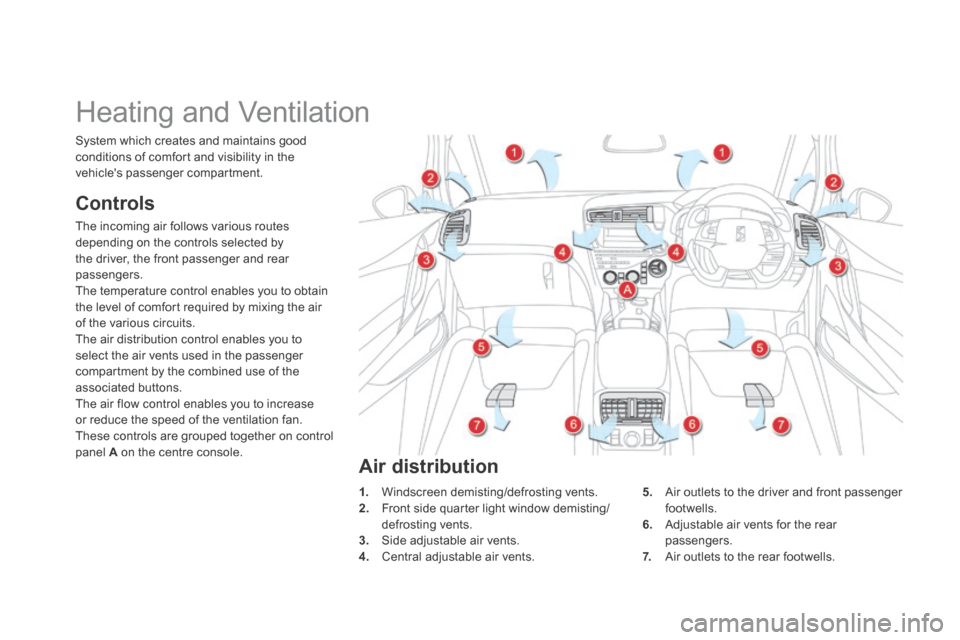
Heating and Ventilation
Controls
The incoming air follows various routes depending on the controls selected by the driver, the front passenger and rear passengers. The temperature control enables you to obtain the level of comfort required by mixing the air of the various circuits. The air distribution control enables you to select the air vents used in the passenger compartment by the combined use of the associated buttons. The air flow control enables you to increase or reduce the speed of the ventilation fan. These controls are grouped together on control panel A on the centre console.
1. Windscreen demisting/defrosting vents. 2. Front side quarter light window demisting/defrosting vents. 3. Side adjustable air vents. 4. Central adjustable air vents.
System which creates and maintains good conditions of comfort and visibility in the vehicle's passenger compartment.
5. Air outlets to the driver and front passenger footwells. 6. Adjustable air vents for the rear passengers. 7. Air outlets to the rear footwells.
Air distribution
Page 126 of 382
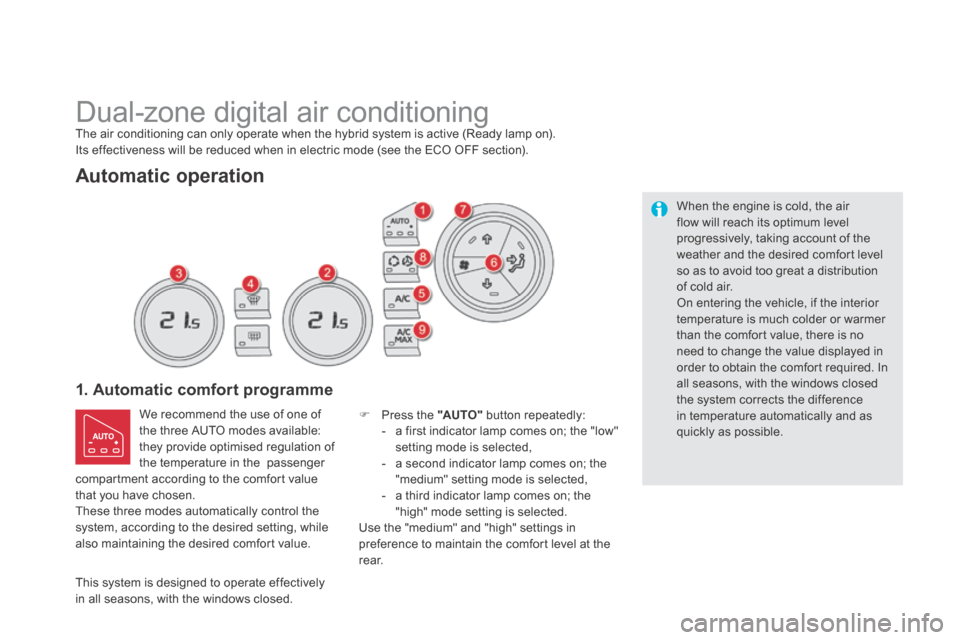
Dual-zone digital air conditioning
1. Automatic comfort programme
We recommend the use of one of the three AUTO modes available: they provide optimised regulation of the temperature in the passenger compartment according to the comfort value that you have chosen. These three modes automatically control the system, according to the desired setting, while also maintaining the desired comfort value.
Press the "AUTO" button repeatedly: - a first indicator lamp comes on; the "low" setting mode is selected, - a second indicator lamp comes on; the "medium" setting mode is selected, - a third indicator lamp comes on; the "high" mode setting is selected. Use the "medium" and "high" settings in preference to maintain the comfort level at the r e a r.
When the engine is cold, the air flow will reach its optimum level progressively, taking account of the weather and the desired comfort level so as to avoid too great a distribution of cold air. On entering the vehicle, if the interior temperature is much colder or warmer than the comfort value, there is no need to change the value displayed in order to obtain the comfort required. In all seasons, with the windows closed the system corrects the difference in temperature automatically and as quickly as possible.
This system is designed to operate effectively
in all seasons, with the windows closed.
Automatic operation
The air conditioning can only operate when the hybrid system is active (Ready lamp on). Its effectiveness will be reduced when in electric mode (see the ECO OFF section).
Page 128 of 382

5. Air conditioning On / Off
Press this button to switch off the air conditioning.
Switching the system off could result in discomfort (humidity, condensation). Press this button again to return to automatic operation of the air conditioning. The indicator lamp in the "A /C " button comes on. To obtain cool air more quickly, you can use recirculation of the interior air for a few moments. Then revert to the intake of exterior air.
6. Air distribution adjustment
Press one or more buttons to direct the air flow towards:
- the windscreen and side windows, - the outer and centre air vents, - the footwells. You can combine the three orientations to obtain the desired air distribution.
7. Air fl ow adjustment
Turn this control to the left to decrease the air flow or to the right to increase the air flow.
The air flow indicator lamps, between the two fans, come on progressively in relation to the value requested.
8. Air intake / Air recirculation
Air recirculation enables the passenger compartment to be isolated from exterior odours and smoke when external pollution is detected (if your vehicle is fitted with a pollution sensor).
It is activated automatically on operation of the screenwash. It is inactive when the ambient temperature is below 5 °C to avoid the risk of misting in the vehicle.
- The indicator lamp with "A" on indicates that recirculation is controlled automatically. - The indicator lamp without "A" on indicates that recirculation is forced manually. - Both indicator lamps off indicates that recirculation is controlled automatically without taking account of the detection of pollution.
Without pollution sensor
If your vehicle is not fitted with a pollution sensor, press this button to force recirculation manually.
In ZEV mode, the hybrid system may temporarily inhibit operation of the air conditioning.
The ZEV mode gives preference to electric driving rather than maintaining a comfortable temperature.
Page 130 of 382
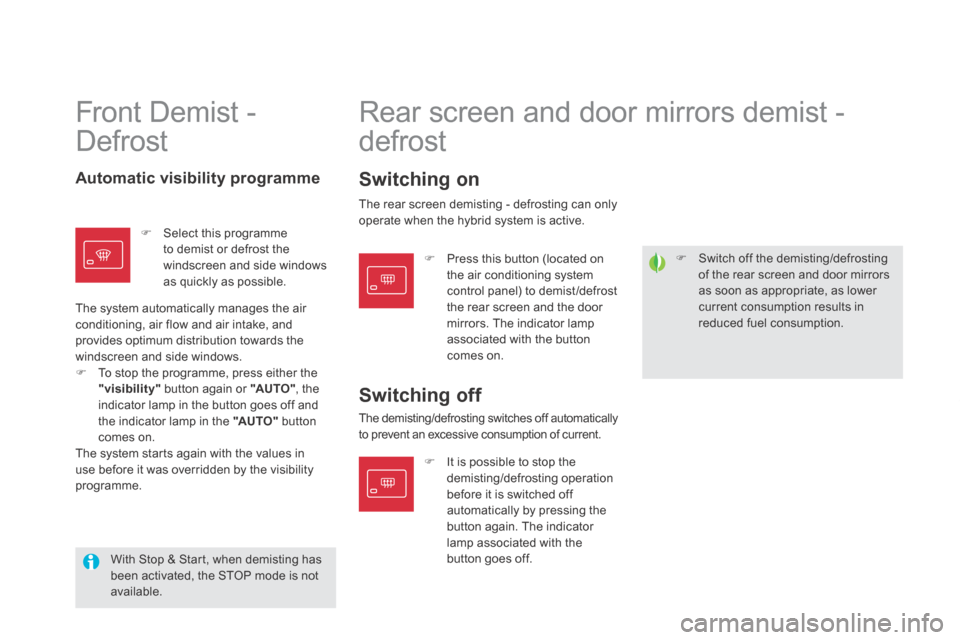
Switch off the demisting/defrosting of the rear screen and door mirrors as soon as appropriate, as lower current consumption results in reduced fuel consumption.
Front Demist -
Defrost Rear screen and door mirrors demist -
defrost
It is possible to stop the demisting/defrosting operation before it is switched off automatically by pressing the button again. The indicator lamp associated with the button goes off.
Automatic visibility programme Switching on
With Stop & Start, when demisting has been activated, the STOP mode is not available.
Switching off
The demisting/defrosting switches off automatically to prevent an excessive consumption of current.
Select this programme to demist or defrost the windscreen and side windows as quickly as possible.
The system automatically manages the air conditioning, air flow and air intake, and provides optimum distribution towards the windscreen and side windows. To stop the programme, press either the "visibility" button again or "AUTO" , the indicator lamp in the button goes off and the indicator lamp in the "AUTO" button comes on. The system starts again with the values in use before it was overridden by the visibility programme.
Press this button (located on the air conditioning system control panel) to demist /defrost the rear screen and the door mirrors. The indicator lamp associated with the button comes on.
The rear screen demisting - defrosting can only operate when the hybrid system is active.
Page 194 of 382
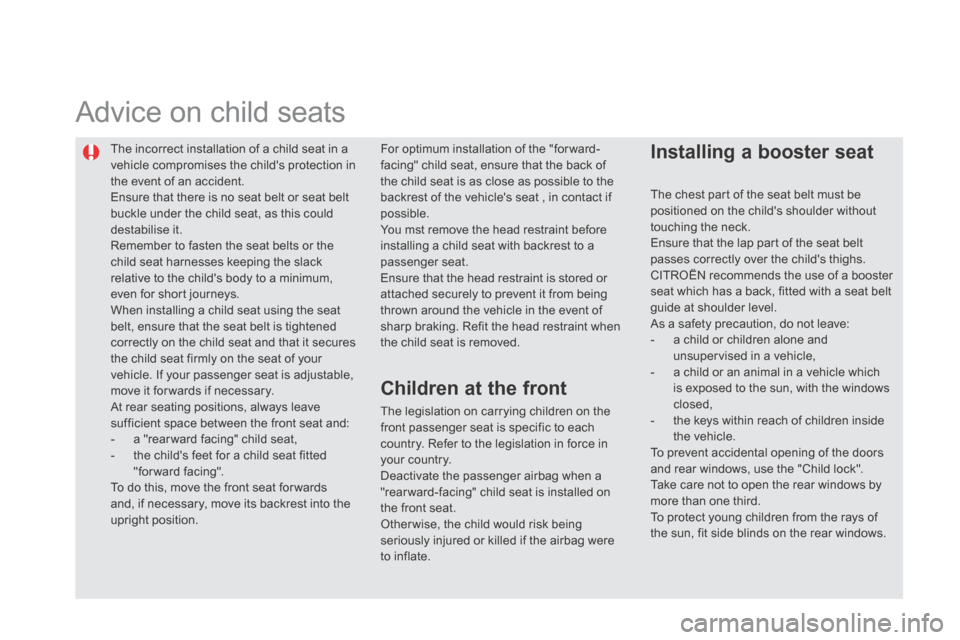
The incorrect installation of a child seat in a vehicle compromises the child's protection in the event of an accident. Ensure that there is no seat belt or seat belt buckle under the child seat, as this could
destabilise it. Remember to fasten the seat belts or the child seat harnesses keeping the slack relative to the child's body to a minimum, even for short journeys. When installing a child seat using the seat belt, ensure that the seat belt is tightened correctly on the child seat and that it secures the child seat firmly on the seat of your vehicle. If your passenger seat is adjustable, move it for wards if necessary. At rear seating positions, always leave sufficient space between the front seat and: - a "rear ward facing" child seat, - the child's feet for a child seat fitted "forward facing". To do this, move the front seat for wards and, if necessary, move its backrest into the upright position.
Advice on child seats
Installing a booster seat
The chest part of the seat belt must be positioned on the child's shoulder without
touching the neck. Ensure that the lap part of the seat belt passes correctly over the child's thighs. CITROËN recommends the use of a booster seat which has a back, fitted with a seat belt guide at shoulder level. As a safety precaution, do not leave: - a child or children alone and unsupervised in a vehicle, - a child or an animal in a vehicle which is exposed to the sun, with the windows closed, - the keys within reach of children inside the vehicle. To prevent accidental opening of the doors and rear windows, use the "Child lock". Take care not to open the rear windows by more than one third. To protect young children from the rays of the sun, fit side blinds on the rear windows.
The legislation on carrying children on the front passenger seat is specific to each country. Refer to the legislation in force in your country. Deactivate the passenger airbag when a "rear ward-facing" child seat is installed on the front seat. Otherwise, the child would risk being seriously injured or killed if the airbag were to inflate.
Children at the front
For optimum installation of the "forward-facing" child seat, ensure that the back of the child seat is as close as possible to the backrest of the vehicle's seat , in contact if possible.
You mst remove the head restraint before installing a child seat with backrest to a passenger seat. Ensure that the head restraint is stored or attached securely to prevent it from being thrown around the vehicle in the event of sharp braking. Refit the head restraint when the child seat is removed.
Page 195 of 382
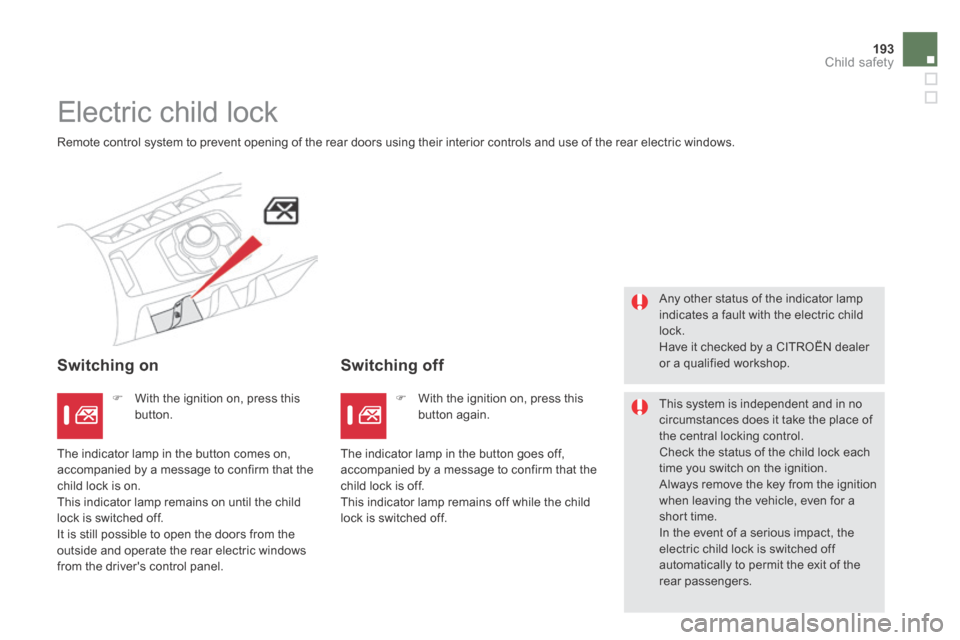
193Child safety
Electric child lock
Remote control system to prevent opening of the rear doors using their interior controls and use of the rear electric windows.
Switching on Switching off
Any other status of the indicator lamp indicates a fault with the electric child lock. Have it checked by a CITROËN dealer or a qualified workshop.
This system is independent and in no circumstances does it take the place of the central locking control. Check the status of the child lock each time you switch on the ignition. Always remove the key from the ignition when leaving the vehicle, even for a short time. In the event of a serious impact, the
electric child lock is switched off automatically to permit the exit of the rear passengers.
With the ignition on, press this button. With the ignition on, press this button again.
The indicator lamp in the button comes on, accompanied by a message to confirm that the child lock is on. This indicator lamp remains on until the child lock is switched off. It is still possible to open the doors from the outside and operate the rear electric windows from the driver's control panel.
The indicator lamp in the button goes off, accompanied by a message to confirm that the child lock is off. This indicator lamp remains off while the child lock is switched off.
Page 209 of 382
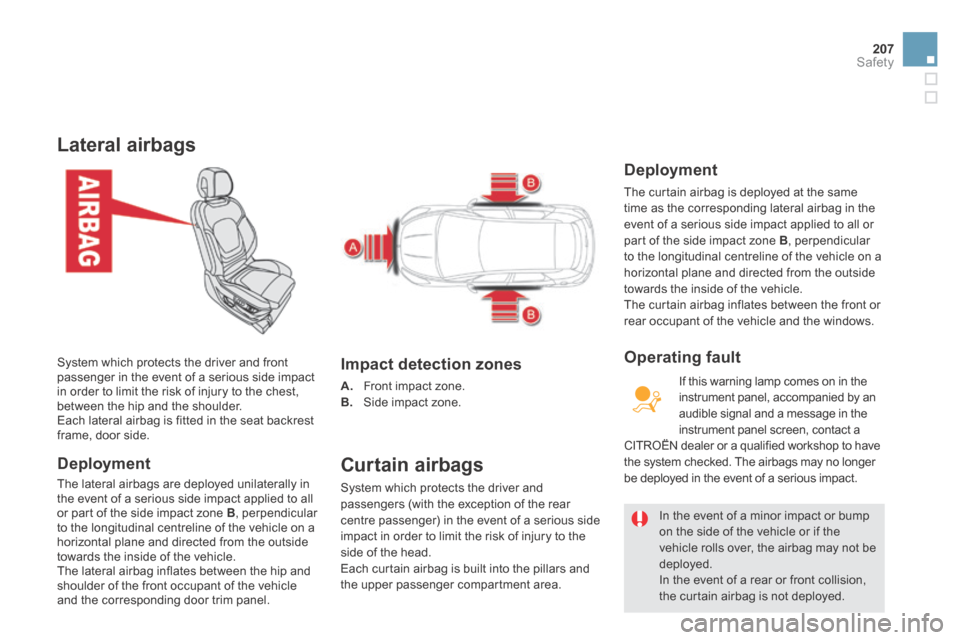
207Safety
Lateral airbags
Deployment
The lateral airbags are deployed unilaterally in the event of a serious side impact applied to all or part of the side impact zone B , perpendicular to the longitudinal centreline of the vehicle on a horizontal plane and directed from the outside towards the inside of the vehicle. The lateral airbag inflates between the hip and shoulder of the front occupant of the vehicle and the corresponding door trim panel.
System which protects the driver and front passenger in the event of a serious side impact in order to limit the risk of injury to the chest, between the hip and the shoulder. Each lateral airbag is fitted in the seat backrest frame, door side.
Impact detection zones
A. Front impact zone. B. Side impact zone.
Curtain airbags
System which protects the driver and passengers (with the exception of the rear centre passenger) in the event of a serious side impact in order to limit the risk of injury to the side of the head. Each curtain airbag is built into the pillars and the upper passenger compartment area.
In the event of a minor impact or bump on the side of the vehicle or if the vehicle rolls over, the airbag may not be deployed. In the event of a rear or front collision, the curtain airbag is not deployed.
Deployment
The curtain airbag is deployed at the same time as the corresponding lateral airbag in the event of a serious side impact applied to all or part of the side impact zone B , perpendicular to the longitudinal centreline of the vehicle on a horizontal plane and directed from the outside towards the inside of the vehicle. The curtain airbag inflates between the front or rear occupant of the vehicle and the windows.
If this warning lamp comes on in the instrument panel, accompanied by an audible signal and a message in the instrument panel screen, contact a CITROËN dealer or a qualified workshop to have the system checked. The airbags may no longer be deployed in the event of a serious impact.
Operating fault
Page 242 of 382
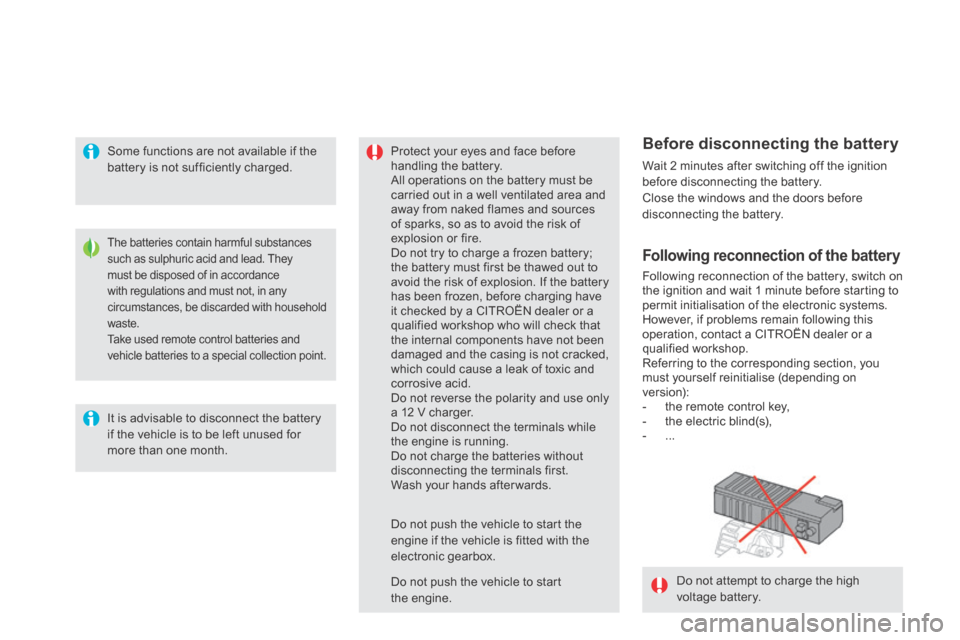
Do not attempt to charge the high
voltage battery.
The batteries contain harmful substances such as sulphuric acid and lead. They must be disposed of in accordance with regulations and must not, in any circumstances, be discarded with household waste. Take used remote control batteries and vehicle batteries to a special collection point.
It is advisable to disconnect the battery
if the vehicle is to be left unused for more than one month.
Protect your eyes and face before handling the battery. All operations on the battery must be carried out in a well ventilated area and away from naked flames and sources of sparks, so as to avoid the risk of explosion or fire. Do not try to charge a frozen battery; the battery must first be thawed out to avoid the risk of explosion. If the battery has been frozen, before charging have it checked by a CITROËN dealer or a qualified workshop who will check that the internal components have not been damaged and the casing is not cracked, which could cause a leak of toxic and corrosive acid. Do not reverse the polarity and use only a 12 V charger. Do not disconnect the terminals while the engine is running. Do not charge the batteries without disconnecting the terminals first. Wash your hands after wards.
Do not push the vehicle to start the engine if the vehicle is fitted with the electronic gearbox.
Before disconnecting the battery
Wait 2 minutes after switching off the ignition before disconnecting the battery. Close the windows and the doors before disconnecting the battery.
Following reconnection of the battery
Following reconnection of the battery, switch on the ignition and wait 1 minute before starting to permit initialisation of the electronic systems. However, if problems remain following this operation, contact a CITROËN dealer or a qualified workshop. Referring to the corresponding section, you must yourself reinitialise (depending on version): - the remote control key, - the electric blind(s), - ...
Do not push the vehicle to start the engine.
Some functions are not available if the battery is not sufficiently charged.
Page 249 of 382
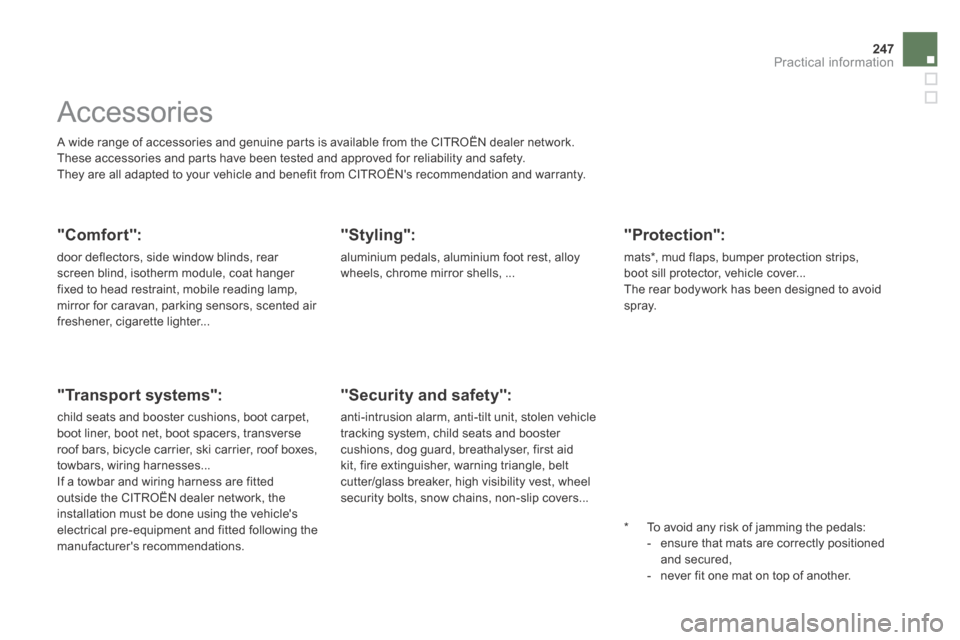
247Practical information
Accessories
A wide range of accessories and genuine parts is available from the CITROËN dealer network. These accessories and parts have been tested and approved for reliability and safety. They are all adapted to your vehicle and benefit from CITROËN's recommendation and warranty.
"Comfort":
door deflectors, side window blinds, rear screen blind, isotherm module, coat hanger fixed to head restraint, mobile reading lamp, mirror for caravan, parking sensors, scented air freshener, cigarette lighter...
"Transport systems":
child seats and booster cushions, boot carpet, boot liner, boot net, boot spacers, transverse roof bars, bicycle carrier, ski carrier, roof boxes, towbars, wiring harnesses... If a towbar and wiring harness are fitted outside the CITROËN dealer network, the installation must be done using the vehicle's electrical pre-equipment and fitted following the
manufacturer's recommendations.
"Styling":
aluminium pedals, aluminium foot rest, alloy wheels, chrome mirror shells, ...
* To avoid any risk of jamming the pedals: - ensure that mats are correctly positioned and secured, - never fit one mat on top of another.
"Security and safety":
anti-intrusion alarm, anti-tilt unit, stolen vehicle tracking system, child seats and booster cushions, dog guard, breathalyser, first aid kit, fire extinguisher, warning triangle, belt cutter/glass breaker, high visibility vest, wheel security bolts, snow chains, non-slip covers...
"Protection":
mats * , mud flaps, bumper protection strips, boot sill protector, vehicle cover... The rear bodywork has been designed to avoid s p r ay.